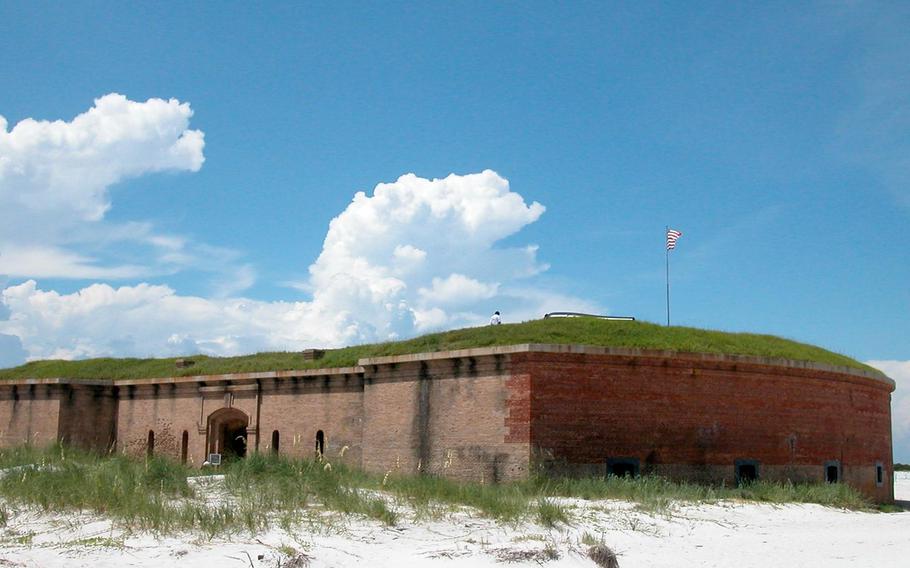
Fort Massachusetts is located along Ship Island’s northwestern shore near a boat pier, and was in use by the United States Army until 1903 before it became a tourist attraction. (National Park Service)
(Tribune News Service) — Twelve miles and a one-hour ferry ride away from the beaches of Gulfport and Biloxi lies a small island with a landmark from Civil War history well known by Mississippi Coast locals.
You may know it better as Ship Island, a popular spot to enjoy warm sandy beaches and view Fort Massachusetts, a brick fortification constructed around Civil War times for coastal defense.
The fort is located along the island's northwestern shore near a boat pier, and was in use by the United States Army until 1903 before it became a tourist attraction. Though it was damaged significantly in hurricanes Camille and Katrina, the fort still stands to this day.
Here is a timeline of events detailing some important moments during this historic fort's construction and its role in the Civil War.
1845-’46
After Texas was annexed, Sen. Jesse Speight of Mississippi wrote a resolution inquiring to President James K. Polk about the construction of a fort on Ship Island to protect the coast. The practicality of this project was discussed by the Board of Engineers in the next year, who thought that though coastal Mississippi didn't seem to be a likely landing spot for enemies, having a military fort on Ship Island could serve the purpose of protecting commerce and be a refueling station for gunboats and oceangoing fleets.
March 1857
The Fortifications Bill was signed into law. It allocated $100,000 to build fortifications on Ship Island for a structure that would later be known as Fort Massachusetts.
June 1859
Construction on the fort began under the Army Corps of Engineers and involved contributions from various civilians, including carpenters, stonemasons, blacksmiths and stonecutters. The brick walls that the fort is known for were first worked on during this inaugural year, and would continue to be built and maintained through 1866.
January 1861
Mississippi seceded from the Union and became the second state of the Confederacy. Militia forces took control of Ship Island and the fort (which had not yet been completed) on Jan. 26. These forces attempted to continue the fort's construction, fortify its walls, and arm the island with cannons over the following few months.
July 9, 1861
On this day, the only military engagement in which Ship Island and the fort would be directly involved occurred. A Union Navy ship called the USS Massachusetts came within range of the Confederate cannons and guns that had been constructed on the island. Then ensued a 20 minute cannon-fire exchange, resulting in minimal injuries and damage of property for both sides.
September 1861
The abandonment of Ship Island was ordered by Confederate Gen. David E. Twiggs. Fires were set to the still unfinished fort and other buildings on the island.
Fall 1861
The fort was taken by Union military forces soon after Confederate forces abandoned the island. Under the control of Lt. John C. Palfrey, work resumed on the fort's construction and it was completed. The cost of the project totaled around $187,000 and used an estimated one million bricks.
1862-’65
Union military forces used the island throughout the remainder of the Civil War. By spring of 1862, the island harbored up to 18,000 U.S. troops, and was used in the Union's capture of New Orleans. Nearly 40 buildings were erected during this time period, including barracks, a mess hall, a bakery and a hospital.
The island's living conditions were not ideal, and many soldiers met their end at Fort Massachusetts during the Civil War. At least 230 Union soldiers died and were buried on the island. Their bodies were later moved to Chalmette National Cemetery in Louisiana.
The fort was never given an official title, but became commonly known as Fort Massachusetts after Major General Winfield S. Hancock called it such in 1884. It was presumably named in honor of the USS Massachusetts.
(c)2023 The Sun Herald (Biloxi, Miss.)
Visit The Sun Herald (Biloxi, Miss.) at www.sunherald.com
Distributed by Tribune Content Agency, LLC.